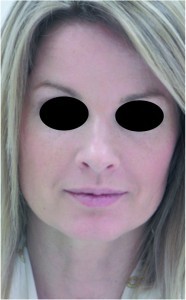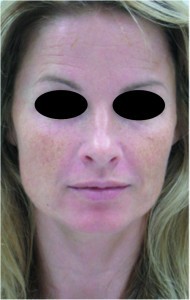Results
In Asian countries, the INTRAcel has been available since 2009, and in Europe since 2011. In the author’s clinic, treatments using this device began in April 2011 and over 800 treatments have been performed to date. The main indications for the treatment have been rejuvenation and acne scars. In addition of the tightening effect, the lifting effect of the sagging skin of the face and neck is remarkable.
The author has treated a range of patients including cases of tightening the upper arms, elbows, and knees, and treating stretch marks and other scars on the body — all of which have reaped good results. The INTRAcel treatment also reduces telangiectasia, but is not the treatment of choice for this indication.
INTRAcel is effective for a variety of types of acne scars. The author has seen clear improvements — even with the most difficult ice-pick scars. It can also be used safely for patients who have undergone previous ablative laser resurfacing treatments.
Indeed, the author’s personal experience with INTRAcel treatment in mild acne is encouraging — sebum secretion is diminished and inflammation decreased. However, in moderately inflamed acne the sebum secretion can be increased for a short period after the first treatment, resulting in a transient worsening of acne and requiring supportive topical treatment or oral medication. Good treatment response can be achieved by combining topical treatments and LED therapy. At present, the INTRAcel treatment option for acne remains for cases unresponsive to common treatment strategies. Severe acne should first be treated with oral medication.
In skin rejuvenation there is an immediate treatment effect followed by a gradual improvement over 4–8 weeks. In facial rejuvenation, the full face, including eyelids and neck, can be treated in the same session. Although a single INTRAcel treatment gives immediately visible results, for a longer-lasting rejuvenation effect, up to three once monthly treatments may be required; while for deeper acne scars and stretch marks up to five treatments may be necessary. The recovery time following subsequent treatment sessions seems to become shorter compared with the first treatment.
The final improvement of the skin is a gradual process and takes a number of weeks, or even months. As the treatment result is totally natural, it is important to take pre- and post-treatment photographs. The routine comparison of photos during visits enables the physician to demonstrate the progressive clinical improvement, as changes are often bigger than the patient may notice or remember. This seems to be especially important while using the FRM-bipolar treatment mode alone. FRM‑monopolar and superficial RF treatment modes also achieve immediately visible results.
Treatment regimens
The treatment is performed under topical anaesthesia. In the author’s clinic, the advanced combined topical anaesthetic protocol was developed, which combines topical anaesthetic cream with a superficial mild trichloroacetic acid (TCA) peel and adrenaline. The advanced protocol makes the treatment painless and avoids the risk of bleeding and bruising, while reducing downtime. The side-effects of the INTRAcel while using this procotol are slight redness and oedema. These normal, transient, procedure-related symptoms often resolve within 24 hours. Rarely, patients can experience dry skin for a maximum of 2 weeks. Interestingly, patients with atopic skin report their skin condition clearly improving. The reactivation of pre-existing herpes infection is possible, but rare. In these cases oral antiviral medication is recommended. The author’s patients have not reported post-treatment pain.
After the treatment, post-treatment moisturising cream is used from two- to four-times per day, and a broad‑spectrum SPF 30 sunscreen is recommended for daily use for at least 2 months in order to avoid sun damage. During the 18 months that the author has used this treatment methodology, no pigmentation disorders have been noted in the Scandinavian patients (mostly skin types I–III), even though many will take regular vacations in strong sunshine.

Figure 2b. Female patient, aged 42 years, showing the first signs of ageing. After two INTRAcel treatment sessions
Patient satisfaction after this combination treatment modality is high and most of the patients return for maintenance treatment after 1 year. In dermal rejuvenation, maintenance procedures are based on individual need, age and condition (usually one or two treatment sessions once per year). Sometimes, in patients over 60 years of age, the author will perform a maintenance treatment every 6 months.
INTRAcel seems to represent a new standard for skin rejuvenation and treatment for acne scarring for all skin types, and with little downtime. The ideal patient for non‑surgical rejuvenation has mild-to-moderate signs of ageing. INTRAcel is also suitable for the correction of the more progressive signs of ageing. In such cases, in order to correct the volume loss and support the strongly sagging tissues, it is useful to perform the combination treatment with volumising fillers using the cannula technique with appropriate vectors. It is important to use a volumising filler that has maximum purity, and good homogeneity and viscosity, giving the desired long‑lasting lifting and volumising effect, with an even and natural looking result.
In a more comprehensive aesthetic treatment approach, the treatment regimen can involve other individual or maintenance aesthetic treatments such as chemical peels, mesotherapy, fillers, botulinum toxin A, LED therapy, photodynamic therapy, and surgical treatments.




